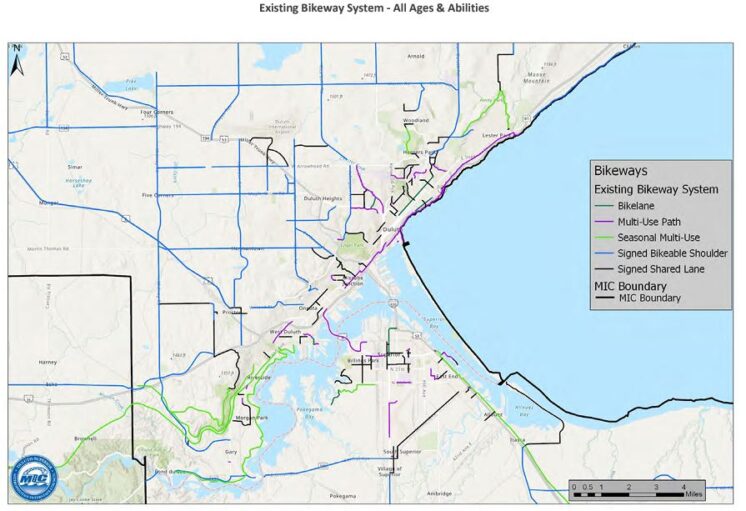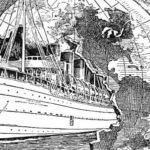Duluth Mail Bag: Tourism Taxes, Bike Lanes and Bonding
 As a two-time Duluth city councilor, now in my final year of service, one of my goals is to make city government more accessible, or at least help citizens become more informed. I figure there are many Duluthians who would like some simple answers to some simple questions. I learned in school that if there is something you don’t understand it’s likely there are many others who feel the same way. Hence the idea of the Duluth Mailbag column.
As a two-time Duluth city councilor, now in my final year of service, one of my goals is to make city government more accessible, or at least help citizens become more informed. I figure there are many Duluthians who would like some simple answers to some simple questions. I learned in school that if there is something you don’t understand it’s likely there are many others who feel the same way. Hence the idea of the Duluth Mailbag column.
I won’t divulge who is asking the questions, but I’ll answer them in this format about once a month. Feel free to put a question in the comments for next month’s “Duluth Mailbag” or tweet me via @Hobbs_Duluth or email me at hobbsforduluth @ gmail.com.
Also, if you want to have a longer conversation, you can sign up for a 45-minute cup of coffee through my 100 Cups of Coffee project.
Apologies for the delay in this column, I’ve been chasing Springsteen across the country and watching the Twins clinch the AL Central. OK, here we go!
How much does tourism contribute to Duluth’s economy?
This is a question with a multi-faceted answer. Tourism tax collections in 2022 totaled nearly $13.8 million with nearly 7 million tourists visiting. Tourists spent nearly $350 million, generating nearly $1 billion in economic impact while contributing to the employment of nearly 17,000 workers.
Why does Duluth focus heavily on tourism?
This sentiment normally percolates around election years. The very quick answer is: it is one of several industries Duluth focuses on. It has a significant affect on the local economy and lowers the property-tax burden to pay for city services.
The long multifaceted answer is that Duluth focuses on a variety of sectors to build its economy on, such as aviation, higher education, healthcare, shipping, manufacturing and tourism. Duluth’s economy is strongly influenced by all of these sectors.
The impact of tourism in Duluth is significant. In addition to the estimated billion-dollar economic impact, tourism also allows for a city of Duluth’s size to have amenities that otherwise wouldn’t exist, like the Lake Superior Zoo, Great Lakes Aquarium and Spirit Mountain.
It is also worth mentioning Duluth has a 1 percent sales tax that goes into the general fund to assist in supporting core city services, as well as a 0.5 percent sales tax that goes toward street repair and maintenance. While locals also pay these taxes, they are a way to capture the cost of local services provided. Fifteen percent of the general fund is made up of sales tax revenues — about $15 million.
How big is Duluth’s budget?
For 2024 the proposed budget is $416.72 million.
It is important to note, however, that what is often inaccurately referred to as the “budget” is actually the general fund. The proposed general fund for 2024 is $108.5 million. This $108 million is made up of 32 percent local government aid ($35.15 million), 27 percent property taxes ($28.88 million) and 15 percent city sales tax ($15.78 million). The rest of the general fund is made up of smaller sources. “Charges for sources,” “all other intergovernmental,” “all other taxes,” “licenses, permits, and fines” and “miscellaneous” make up the rest.
Why the difference?
The city of Duluth, like most municipalities, has various funds. In Duluth there are several enterprise funds, like Comfort Systems, parking and golf. These city “enterprises” allow the city to generate revenue through a user fee (parking meters, golf rounds, gas/water bills) to cover the costs of providing a service to the public and allow those who use the service to pay for it directly.
There are also internal service funds, capital project funds, debt-service funds and special revenue funds. Duluth has several special revenue funds for things like street lighting, street maintenance, utilities, parks … and the tourism tax mentioned above. Special revenue funds must be used for their “special” purpose. For example, the parks money can’t be used for street maintenance or vice versa.
How does bonding work?
If you or I want a loan for a car or a house, we go to a bank or credit union. But cities don’t work that way. Cities may not borrow money from banks through conventional loans to finance local improvements. Cities commonly raise capital to pay for local improvements by issuing debt. Specifically, cities incur debt and borrow money by issuing and selling municipal bonds also known as general obligation bonds. GO bonds often create funding tied to a specific use (such as water systems, sewer systems, public facilities, etc.) but are backed by the taxing power of the city. In a municipal bond, all of the city’s assets and resources, including its unlimited taxing power, guarantee that the bond will be paid back. The security for a GO bond is the pledge of those resources and taxing powers. There are limits on the amount of debt a city may incur through the issue and sale of bonds. Currently, the “net debt” limit is 3 percent of the estimated market value of taxable property in the city. In some situations, residents must vote in favor of a bond before the city may issue them. However, there are many exceptions to this requirement.
For example, Duluth could bond for its street repair, and repair a higher number of roads immediately (or water mains, etc.). However, the issue with that, much like putting large purchases on your personal credit card, is it costs more money down the road (pun intended). At some point, the city will be paying more for debt service than actual miles constructed or repaved. These interest rates fluctuate on the market as well. However, these rates are not as high as our credit card interest rates. In the long run, this approach may not be the most judicious, but it’s certainly appealing in the short term.
What is the process for community development funds being spent? Is it transparent?
The Community Development Block Grant program was established under President Gerald Ford in 1974. It supports community development activities to build stronger and more resilient communities. An ongoing process is used to identify activities that support community development. Activities may address needs such as infrastructure, economic development projects, public facilities installation, community centers, housing rehabilitation, public services, clearance/acquisition, microenterprise assistance, code enforcement, homeowner assistance, etc. These funds are federal allocations to states, counties and cities. It is worth noting that funding for CDBG has remained steady in nominal dollars at roughly $3 billion, but funding has not kept up with inflation. Over the past 40 years, funding has decreased from $15 billion in 1974 to $3 billion in 2020, and has declined every year since 1995.
Duluth receives about $3 million per year in CDBG funds. The city works with its partners to create a Consolidated Plan every five years and lays out how Duluth will spend the funds. (Click here for the 2020 to 2024 Consolidated Plan if you’re interested). As part of its community development program, Duluth appoints members to its Community Development Committee, which develops priorities, reviews applications, makes funding recommendations and evaluates performance. The Community Development Committee meetings are public meetings typically held on the third or fourth Tuesday of each month at 5:30 p.m.
This is a long answer to say the process is transparent and hopefully, if you would like to participate more, you can apply to be on the Community Development Committee, or you can attend their meetings.
Why does Duluth have so many bike lanes?
Ah, the age-old lament from online commenters that the city of Duluth is only focused on bike lanes.
Duluth has about 12.5 miles of bike lanes on 450 miles of roads. Yet the city of Duluth is responsible for only about one-half mile of dedicated bike lanes in the city, which is the protected bike lane in Lincoln Park. In my six years on the council that is the only dedicated bike lane that has come across the council dais.
There are other bike lanes in the city such as on Fourth Street, the overpass on Interstate 35, and on Grand Avenue from West Duluth to Gary, but those are Minnesota Department of Transportation and St. Louis County projects. The rest of the bike lanes in the city of Duluth are either signed bikeable shoulders, which are white paint on the edge of the road, or signed shared lanes, which are nothing more than a sign asking vehicles to “share the road.”
The Munger Trail, Duluth Lakewalk and Cross City Trail are not “bike lanes,” they are dedicated multi-use trails for everyone — walkers, runners, joggers, rollerbladers, families pushing strollers and people in wheelchairs.
Here is a link to a map of existing bikeways in Duluth and Superior.
Trails used for mountain biking are also multi-use. You can walk/hike them. They are not reserved just for mountain biking, and COGGS takes care of many of these trails. Below is a map of lanes.
What is the MIC?
The Duluth-Superior Metropolitan Interstate Council, commonly referred to as the MIC, is the metropolitan planning organization of the Twin Ports. MPOs set priorities for federal funds on current and future transportation projects. The MIC has a policy board made up of 18 elected officials and citizens who represent all local units of government in the planning area. I served on this board for two years, which was exciting for me given my educational background in urban planning.
The MIC conducts studies, develops plans, and models the transportation system to forecast travel patterns and program projects for federal funding in the MIC planning area.
The overall purpose of transportation planning is to improve the movement of people and goods to their destinations. It is an ongoing and collaborative process that incorporates the input of many stakeholders, including members of the public and representatives of private businesses. Therefore, the MIC is required by federal statute to:
- Produce a long-range transportation plan to address projects, programs and policies for at least a 20-year timeframe.
- Develop a transportation improvement program for projects that receive federal funding in Duluth and Superior.
- Develop, adopt and use a public involvement plan that identifies the overall strategies and specific steps the MIC will take to engage the project stakeholders at each phase of planning.
- Adopt a work program and budget that identify the MIC’s transportation planning activities and budget for a two-year period.
Does Duluth have tiers of property-tax rates for seniors?
As much as it is politically expedient to say yes to this question, the answer is no. For example, there are different rates for commercial versus residential, but the city and county can’t set higher/lower rates for people over/under 65 or based on income.
However, there is a program through the state of Minnesota called “Property Tax Deferral for Senior Citizens.” This program essentially has you pay 3 percent of your total household income as your property tax payment. The state of Minnesota pays the difference as a loan. When you sell your home, you must repay that loan plus interest (which varies but never exceeds 5 percent).
In order to qualify, you must be 65 years old, earn less than $96,000 a year, and have lived in your home for the past five years. Your home must also be your own. Reverse mortgages, life estates or federal liens are not allowed. Other liens against the property must be 75 percent or less of the estimated market value.
The application deadline is Nov. 1. If you’re reading this and know of a senior citizen who could benefit from this program let them know.
Recommended Links:
Leave a Comment
Only registered members can post a comment , Login / Register Here













1 Comment
hamptonio
about 1 year ago